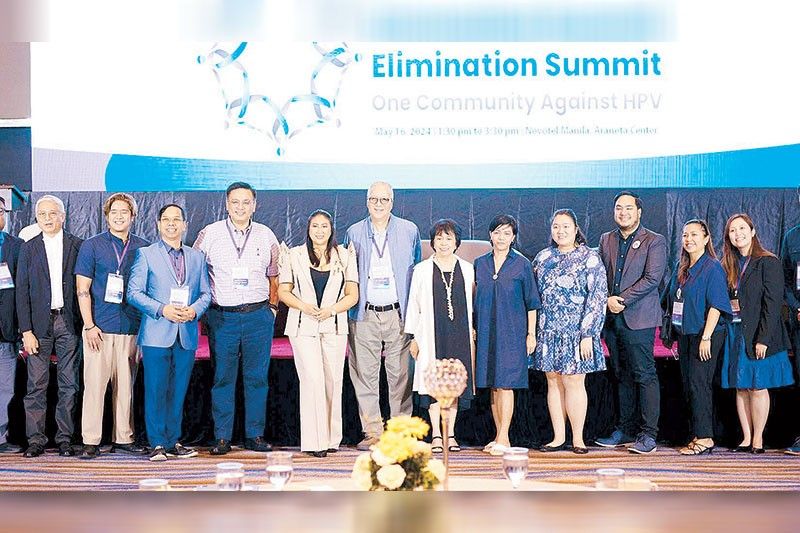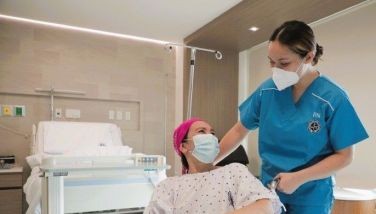No woman should stand alone in her fight against cervical cancer


For someone who started playing football at 12 and made a professional career out of it, staying out of the field for good — due to cancer — is, indeed, a bitter pill to swallow.
Philippine National Team for Women’s Football former player and coach Isabella “Belay” Fernando Dela Cruz’s life dramatically changed when she was diagnosed with stage 3 cervical cancer six years ago.
“So much that I could no longer do some of the things I love most — sports,” she shared. “I developed neuropathy because of my cancer treatments. And with that, I couldn’t kick a ball like I used to.”
When Belay got confirmation that she had cancer, one of the first thoughts in her head was, “Could I have prevented this?”
As an athlete, Belay was always on the go.
“I never stopped for rest or leisure, not even for my health,” Belay added. “Maybe if I wasn’t so busy neglecting my health, I could have seen this coming.”
Before her diagnosis, Belay was so wrapped up with work and made health the least of her priorities, despite experiencing concerning symptoms like vaginal discharge and severe pain. Well, she should have known better because her mom got diagnosed with stage 4 colon cancer back then.
“And as someone who had experienced the burden of cancer in the family, I knew that the human papilloma virus (HPV) can be scary,” Belay related. “I went through a lot of difficult moments. I got hospitalized for a month because of complications. Thank goodness for my family and friends, I got all the resources and support needed throughout my treatment, so I was able to focus on getting well.”
Sadly, that’s not the case for everyone.
Cervical cancer is a serious condition that demands serious attention.
That’s why as a way of giving back, Belay has made it her mission to raise awareness on cervical cancer.
“My doctor tells me that it usually takes eight to 10 years for cancer to develop. So, it’s important for women to protect themselves with the vaccine and screening while they still can,” advised Belay. “In an ideal world, women need not experience what I have experienced because there are actionable steps to take.”
Cervical cancer is preventable. Yet, there are still Filipinas who get diagnosed with the disease each day.
One community against HPV

Belay is one of the cervical cancer advocates who shared their inspiring stories at the recent First Philippine Cervical Cancer Elimination Summit, titled “One Community Against HPV.”
In celebration of the Cervical Cancer Awareness Month this May, the summit, organized by MSD in the Philppines, convened health experts, advocacy groups, policymakers, and private sectors to accelerate progress toward a cervical-cancer-free future for millions of Filipino women.
HPV, a sexually transmitted infection, is the leading cause of most cervical cancer. This deadly disease remains a burden, especially in low-resource countries like the Philippines where facilities for prevention, screening, diagnosis and treatment are lacking.
In May 2018, the World Health Organization announced a global call for action to eliminate cervical cancer, underscoring political will to make this dream a reality and calling on all stakeholders to unite behind this common goal. To eliminate cervical cancer, all countries must reach and maintain an incidence rate below four per 100,000 women in Asia and Latin America.
“As one community, we need to create awareness and understanding of cervical cancer in the Philippines to foster a multi-stakeholder collaboration to trigger effective and efficient screening and elimination,” said Karlo Paredes, market access and corporate affairs director, MSD Philippines.
Cervical cancer elimination in the Philippines is, indeed, possible if the country can meet its 90-70-90 targets based on the World Health Organization’s (WHO) global strategy. This goal rests on three key pillars: vaccinating 90% of girls with the HPV vaccine by age 15, screening 70% of women with high-performance tests by ages 35-45, and treating 90% of women with pre-cancer and invasive cancer.
Sadly, the Philippines is severely lagging behind these targets, with only four percent of the target cohort having received their first dose of the HPV vaccine and a mere one percent of the country’s population completing the recommended doses.
“Based on mathematical models, the Philippines is set to achieve cervical cancer elimination between 2071 and 2098,” said Frances Ngo of the UP National Institutes of Health (NIH). “This model will not work if we are going to maintain our status quo; we need to be on track of our 90-70-90 targets if we’re going to eliminate cervical cancer within this century.”
Medical experts at the summit emphasized that meeting these targets is crucial to reducing cervical cancer incidence in less than four per 100,000 women, which is the threshold of elimination.
They stressed that urgent action is needed, as cervical cancer remains a significant public health threat in the country, claiming 12 lives daily and putting almost 40 million Filipino women at risk.
Race against time

HPV vaccines are most effective when administered before exposure to the virus, which typically occurs through sexual activity. By vaccinating girls and young women early, preferably before they become sexually active, the Philippines can protect its women against the most common cancer-causing HPV genotypes.
Dr. John Wong, chair and president of Epimetrics, highlights the urgent need to immunize women and speed up the awareness drive in the country.
Like any virus, HPV strains adapt and evolve. Although vaccines targeting cancer-causing strains of HPV are now available, Dr. Wong warns that delaying vaccination efforts could lead to the emergence of new, potentially more dangerous HPV strains.
“We need to administer vaccines quickly. As time passes, the genotypes change,” said Dr. Wong. “Our current nonavalent vaccine is effective, but who knows, maybe in the next nine years, it will be difficult. There’s really an urgency to accelerate our efforts.”
During the summit, MSD in the Philippines also reaffirmed its unwavering commitment to use the power of leading-edge science to save and improve lives of patients.
“We will also continue collaborating with stakeholders to find solutions to enable sustainable preventive measures for HPV and HPV-related diseases, including cervical cancer, access to public cancer care services and treatment for all Filipino patients, regardless of their socio-economic status,” Paredes added.
Ilocos Norte town leads the way towards cervical cancer-free PH
To safeguard the young girls of Banna, Ilocos Norte, from the HPV virus, Mayor Chrislyn Abadilla, who is a medical director by profession, persuaded her constituents to support the immunization program being spearheaded by the Department of Health and the Department of Education.
Close to 1,000 girls aged nine to 14 completed their immunization on the same day, making this town the first municipality in the Philippines to achieve 90% vaccination towards eliminating cervical cancer.
To achieve this, Mayor Abadilla directed all the barangay captains to gather all pertinent data and sought help of DepEd to spread awareness on cervical cancer in schools.
“It’s about pushing ourselves to the limit,” said Mayor Abadilla. “If a small town in Ilocos Norte can do it, any other municipality could do it, too!”
Whole-of-society approach
Stakeholders at the summit expressed their commitment to the battle towards cervical cancer elimination. The Department of Health pledged to strengthen its cervical cancer prevention and control programs. At the same time, local government units vowed to improve access to HPV vaccination and screening services in their communities. Healthcare providers committed to increasing awareness and uptake of these services, and patient advocates and civil society organizations promised to support elimination efforts.
In a recorded message, Senator Bong Go, chairperson of the Senate Committee on Health, said that the summit’s theme underscores the vital importance of solidarity and collective action needed to achieve its goal of eliminating cervical cancer in the Philippines.
“This is not just our policy imperative, but our moral obligation to protect the health and future of our mothers, daughters and sisters,” he said. “As chair of the Senate Committee on Health, we are consistently pushing for additional budget for the Cancer Assistance Fund to support cancer patients in their treatment. Let us be relentless, compassionate and ensure that no woman stands alone in her fight against cervical cancer.”
The 1st Philippine Cervical Cancer Elimination Summit may have concluded, but the real battle of turning commitments into action has just begun.
The country’s journey towards elimination will require sustained efforts from all sectors of society, but with unity and determination, a future where no Filipina has to suffer from cancer is within reach.



















